List of United States Supreme Court cases, volume 46
| Supreme Court of the United States | |
|---|---|
 | |
| Established | March 4, 1789[1] |
| Location | Washington, D.C. |
| Coordinates | 38°53′26″N 77°00′16″W / 38.89056°N 77.00444°WCoordinates: 38°53′26″N 77°00′16″W / 38.89056°N 77.00444°W |
| Composition method | Presidential nomination with Senate confirmation |
| Authorized by | Constitution of the United States, Art. III, § 1 |
| Judge term length | life tenure, subject to impeachment and removal |
| Number of positions | 9 (by statute) |
| Website | supremecourt |
| Chief Justice of the United States | |
| Currently | John Roberts |
| Since | September 29, 2005 |
| This article is part of the series on the |
| Supreme Court of the United States |
|---|
 |
| The Court |
|
| Current membership |
|
| Lists of justices |
|
| Court functionaries |
|
|
| Constitutional law of the United States |
|---|
 |
| Overview |
|
| Principles |
|
| Government structure |
|
| Individual rights |
|
| Theory |
|
This is a list of the 36 cases reported in volume 46 (5 How.) of United States Reports, decided by the Supreme Court of the United States from December 1846 to March 1847.[2]
Nominative reports[]
In 1874, the U.S. government created the United States Reports, and retroactively numbered older privately-published case reports as part of the new series. As a result, cases appearing in volumes 1–90 of U.S. Reports have dual citation forms; one for the volume number of U.S. Reports, and one for the volume number of the reports named for the relevant reporter of decisions (these are called "nominative reports").
Benjamin Chew Howard[]
Starting with the 42nd volume of U.S. Reports, the Reporter of Decisions of the Supreme Court of the United States was Benjamin Chew Howard. Howard was Reporter of Decisions from 1843 to 1860, covering volumes 42 through 65 of United States Reports which correspond to volumes 1 through 24 of his Howard's Reports. As such, the dual form of citation to, for example, Mayberry v. Thompson is 46 U.S. (5 How.) 121 (1847).
Justices of the Supreme Court at the time of 46 U.S. (5 How.)[]
The Supreme Court is established by Article III, Section 1 of the Constitution of the United States, which says: "The judicial Power of the United States, shall be vested in one supreme Court . . .". The size of the Court is not specified; the Constitution leaves it to Congress to set the number of justices. Under the Judiciary Act of 1789 Congress originally fixed the number of justices at six (one chief justice and five associate justices).[3] Since 1789 Congress has varied the size of the Court from six to seven, nine, ten, and back to nine justices (always including one chief justice). When the cases in 46 U.S. (5 How.) were decided the Court comprised these nine members:
| Portrait | Justice | Office | Home State | Succeeded | Date confirmed by the Senate (Vote) |
Tenure on Supreme Court |
|---|---|---|---|---|---|---|
 |
Roger B. Taney | Chief Justice | Maryland | John Marshall | March 15, 1836 (29–15) |
March 28, 1836 – October 12, 1864 (Died) |
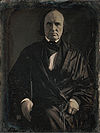 |
John McLean | Associate Justice | Ohio | Robert Trimble | March 7, 1829 (Acclamation) |
January 11, 1830 – April 4, 1861 (Died) |
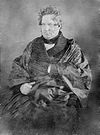 |
James Moore Wayne | Associate Justice | Georgia | William Johnson | January 9, 1835 (Acclamation) |
January 14, 1835 – July 5, 1867 (Died) |
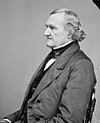 |
John Catron | Associate Justice | Tennessee | newly-created seat | March 8, 1837 (28–15) |
May 1, 1837 – May 30, 1865 (Died) |
 |
John McKinley | Associate Justice | Alabama | newly-created seat | September 25, 1837 (Acclamation) |
January 9, 1838 – July 19, 1852 (Died) |
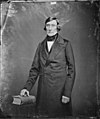 |
Peter Vivian Daniel | Associate Justice | Virginia | Philip P. Barbour | March 2, 1841 (25–5) |
January 10, 1842 – May 31, 1860 (Died) |
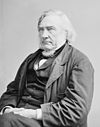 |
Samuel Nelson | Associate Justice | New York | Smith Thompson | February 14, 1845 (Acclamation) |
February 27, 1845 – November 28, 1872 (Retired) |
 |
Levi Woodbury | Associate Justice | New Hampshire | Joseph Story | January 31, 1846 (Acclamation) |
September 23, 1845 – September 4, 1851 (Died) |
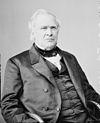 |
Robert Cooper Grier | Associate Justice | Pennsylvania | Henry Baldwin | August 4, 1846 (Acclamation) |
August 10, 1846 – January 31, 1870 (Retired) |
Notable Case in 46 U.S. (5 How.)[]
Jones v. Van Zandt[]
In Jones v. Van Zandt, 46 U.S. (5 How.) 215 (1847), the Supreme Court held that no written or other formal notice of fugitive slave status was required to support a criminal charge of harbouring or concealing a runaway slave who had escaped to a free state.
Citation style[]
Under the Judiciary Act of 1789 the federal court structure at the time comprised District Courts, which had general trial jurisdiction; Circuit Courts, which had mixed trial and appellate (from the US District Courts) jurisdiction; and the United States Supreme Court, which had appellate jurisdiction over the federal District and Circuit courts—and for certain issues over state courts. The Supreme Court also had limited original jurisdiction (i.e., in which cases could be filed directly with the Supreme Court without first having been heard by a lower federal or state court). There were one or more federal District Courts and/or Circuit Courts in each state, territory, or other geographical region.
Bluebook citation style is used for case names, citations, and jurisdictions.
- "C.C.D." = United States Circuit Court for the District of . . .
- e.g.,"C.C.D.N.J." = United States Circuit Court for the District of New Jersey
- "D." = United States District Court for the District of . . .
- e.g.,"D. Mass." = United States District Court for the District of Massachusetts
- "E." = Eastern; "M." = Middle; "N." = Northern; "S." = Southern; "W." = Western
- e.g.,"C.C.S.D.N.Y." = United States Circuit Court for the Southern District of New York
- e.g.,"M.D. Ala." = United States District Court for the Middle District of Alabama
- "Adm." = Admiralty Court (a federal court)
- "Ct. Cl." = United States Court of Claims
- "Ct. Com. Pl." = Court of Common Pleas (a state court)
- The abbreviation of a state's name alone indicates the highest appellate court in that state's judiciary at the time.
- e.g.,"Pa." = Supreme Court of Pennsylvania
- e.g.,"Me." = Supreme Judicial Court of Maine
List of cases in 46 U.S. (5 How.)[]
| Case Name | Page & year | Opinion of the Court | Concurring opinion(s) | Dissenting opinion(s) | Lower court | Disposition of case |
|---|---|---|---|---|---|---|
| Wood v. Underhill | 1 (1846) | Taney | none | none | C.C.S.D.N.Y. | reversed |
| Sewall v. Chamberlain | 6 (1847) | Wayne | none | none | C.C.S.D. Ala. | dismissed for want of jurisdiction |
| Dick & Co. v. Runnels | 7 (1846) | McLean | none | none | C.C.S.D. Miss. | remanded to divided lower court |
| United States v. Lawton | 10 (1847) | Catron | none | none | Fla. Super. Ct. | reversed |
| United States v. Boyd | 29 (1846) | Nelson | none | none | C.C.S.D. Miss. | reversed |
| Pepper v. Dunlap | 51 (1846) | Taney | none | none | La. | dismissed for want of jurisdiction |
| McAfee v. Doremus | 53 (1847) | McLean | none | none | N.D. Miss. | affirmed |
| Walker v. Taylor | 64 (1846) | Grier | none | none | Ky. | dismissed for want of jurisdiction |
| Hildeburn v. Turner | 69 (1847) | Taney | none | none | C.C.S.D. Miss. | remanded to divided lower court |
| Miller v. Herbert | 72 (1847) | Daniel | none | none | C.C.D.C. | reversed |
| Alexandria Canal Co. v. Swann | 83 (1847) | Taney | none | none | C.C.D.C. | affirmed |
| Bridges v. Armour | 91 (1847) | Nelson | none | none | N.D. Miss. | reversed |
| Hall v. Smith | 96 (1847) | Wayne | none | none | C.C.D. Md. | remanded to divided lower court |
| Barry v. Mercein | 103 (1847) | Taney | none | none | C.C.S.D.N.Y. | dismissed for want of jurisdiction |
| Mayberry v. Thompson | 121 (1847) | Taney | none | none | C.C.S.D. Ala. | dismissed for want of jurisdiction |
| Nelson v. Hill | 127 (1847) | Daniel | none | none | C.C.S.D. Ala. | reversed |
| Rowan v. Runnels | 134 (1847) | Taney | none | Daniel | C.C.S.D. Miss. | reversed |
| Truly v. Wanzer | 141 (1847) | Grier | none | none | C.C.S.D. Miss. | affirmed |
| Ford v. Douglas | 143 (1847) | Nelson | none | none | C.C.E.D. La. | reversed |
| Gear v. Parish | 168 (1847) | Nelson | none | none | Sup. Ct. Terr. Wis. | reversed |
| In re Metzger | 176 (1847) | McLean | none | none | original jurisdiction | habeas corpus denied |
| Creath's Adm'r v. Sims | 192 (1847) | Daniel | none | none | C.C.S.D. Miss. | affirmed |
| United States v. Briggs | 208 (1847) | Taney | none | none | C.C.D. Mich. | remanded to divided lower court |
| Sheppard v. Wilson | 210 (1847) | Taney | none | none | Sup. Ct. Terr. Iowa | dismissal denied |
| Miners' Bank v. United States ex rel. Grant | 213 (1847) | Taney | none | none | Sup. Ct. Terr. Iowa | dismissed for want of jurisdiction |
| Jones v. Van Zandt | 215 (1847) | Woodbury | none | none | C.C.D. Ohio | remanded to divided lower court |
| Taylor v. Benham | 233 (1847) | Woodbury | none | none | N.D. Ala. | affirmed |
| Phillips v. Preston | 278 (1846) | Woodbury | none | none | C.C.E.D. La. | continued |
| Cook v. Moffat | 295 (1847) | Grier | Taney, McLean, Daniel, Woodbury | none | C.C.D. Md. | affirmed |
| Innerarity v. Byrne | 295 (1847) | McLean | none | none | not indicated | continued |
| Commercial Bank v. Buckingham's Ex'rs | 317 (1847) | Grier | none | none | Ohio | dismissed for want of jurisdiction |
| Scott v. Jones | 343 (1847) | Woodbury | Wayne | McLean | Mich. | dismissed for want of jurisdiction |
| United States v. Bank of the U.S. | 382 (1847) | Catron | none | McLean | C.C.E.D. Pa. | reversed |
| Fox v. Ohio | 410 (1847) | Daniel | none | McLean | Ohio | affirmed |
| Waring v. Clarke | 441 (1847) | Wayne | none | Catron, Woodbury, Grier | C.C.E.D. La. | reversed |
| License Cases | 504 (1847) | Taney | Catron, Daniel, Grier, McLean, Woodbury | none | Mass., N.H. & R.I. | all affirmed |
Notes and references[]
- ^ Lawson, Gary; Seidman, Guy (2001). "When Did the Constitution Become Law?". Notre Dame Law Review. 77: 1–37.
- ^ Anne Ashmore, DATES OF SUPREME COURT DECISIONS AND ARGUMENTS, Library, Supreme Court of the United States, 26 December 2018.
- ^ "Supreme Court Research Guide". Georgetown Law Library. Retrieved April 7, 2021.
See also[]
- Certificate of division
External links[]
- [1] Case reports in volume 46 (5 How.) from Court Listener
- [2] Case reports in volume 46 (5 How.) from the Caselaw Access Project of Harvard Law School
- [3] Case reports in volume 46 (5 How.) from Google Scholar
- [4] Case reports in volume 46 (5 How.) of Justia
- [5] Case reports in volume 46 (5 How.) from Open Jurist
- Website of the United States Supreme Court
- United States Courts website about the Supreme Court
- National Archives, Records of the Supreme Court of the United States
- American Bar Association, How Does the Supreme Court Work?
- The Supreme Court Historical Society
- Lists of United States Supreme Court cases by volume
- Lists of United States Supreme Court cases
- United States Supreme Court cases
- United States case law lists
- 1846 in United States case law
- 1847 in United States case law

